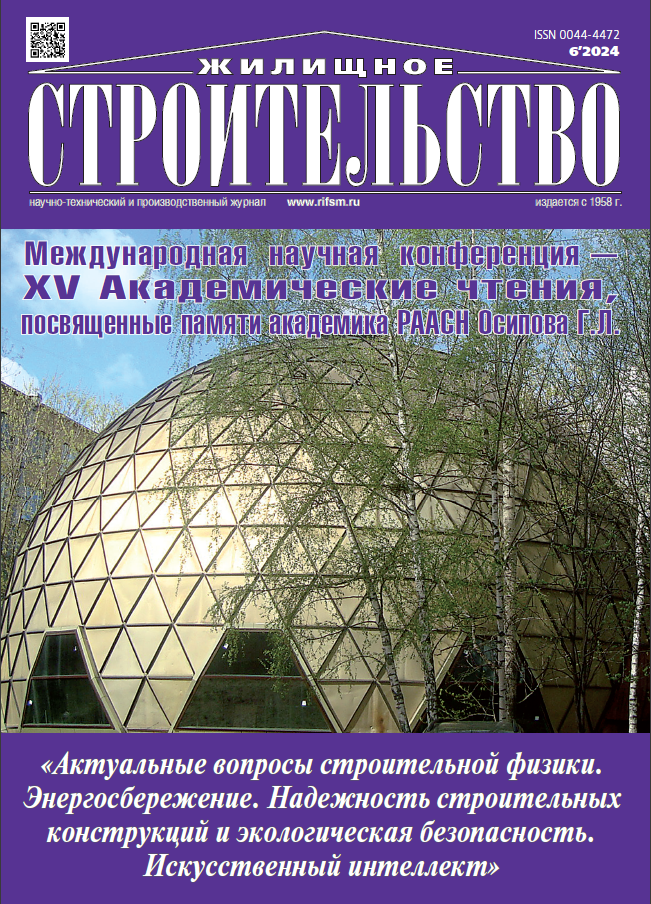Dependence of the Light Transmission Coefficients of Multifunctional Glazing on the Angle of Incidence of Radiation
- Авторлар: Shubin I.L.1, Korkina E.V.1,2, Zemtsov V.V.1, Kucherov S.S.2
-
Мекемелер:
- Scientific-Research Institute of Building Physics of RAACS
- National Research Moscow State University of Civil Engineering
- Шығарылым: № 6 (2024)
- Беттер: 3-9
- Бөлім: Articles
- URL: https://gynecology.orscience.ru/0044-4472/article/view/634814
- DOI: https://doi.org/10.31659/0044-4472-2024-6-3-9
- ID: 634814
Дәйексөз келтіру
Аннотация
The operation of buildings with translucent facades increases the load on the heating and ventilation system due to transmission heat losses through the glazing, and on the air conditioning system due to possible overheating in summer. For this reason, glazing with sun protection, low-emissivity and multifunctional coatings is used in such facades. The characteristics of translucent enclosing structurers, as calculated according to normative documents, are taken into account when calculating the load on heating, ventilation and air conditioning systems, as well as when selecting the structures themselves in a given climate in order to save energy. In this case, the characteristics of the glazing were obtained in laboratory conditions when the radiation is perpendicular to the glazing, which is different from field conditions where the sun rays fall on the glazing at an angle. The available research works on the transmittance of solar radiation falling on glazing at an angle is based on laboratory studies, where various physical processes cannot be manifested and accounted for. Currently, research is being conducted in the Research Institute of Building Physics of the Russian Academy of Architecture and Construction Sciences to determine the empirical dependence of the light transmission coefficients of glazing with special coatings on the angle of incidence of the sun rays. The article presents part of the research and considers the determination of the light transmission coefficient of glazing with and without coatings from the angle of incidence of solar radiation.
Толық мәтін
Авторлар туралы
I. Shubin
Scientific-Research Institute of Building Physics of RAACS
Хат алмасуға жауапты Автор.
Email: shuig@mail.ru
Doctor of Sciences (Engineering), Corresponding Member of RAACS
Ресей, 21, Lokomotivniy Driveway, Moscow, 127238E. Korkina
Scientific-Research Institute of Building Physics of RAACS; National Research Moscow State University of Civil Engineering
Email: elena.v.korkina@gmail.com
Candidate of Sciences (Engineering)
Ресей, 21, Lokomotivniy Driveway, Moscow, 127238; 26, Yaroslavskoe Highway, Moscow, 129337V. Zemtsov
Scientific-Research Institute of Building Physics of RAACS
Email: ins-es@yandex.ru
Engineer
Ресей, 21, Lokomotivniy Driveway, Moscow, 127238S. Kucherov
National Research Moscow State University of Civil Engineering
Email: wysifalay@yandex.ru
Engineer
Ресей, 26, Yaroslavskoe Highway, Moscow, 129337Әдебиет тізімі
- Dvoreckij A.T., Spiridonov A.V., Shubin I.L. Nizkoenergeticheskie zdaniya: okna, fasady, solncezashchita, energoeffektivnost’ [Low energy buildings: windows, facades, sun protection, energy efficiency] Moscow: Direct-Media. 2022. 232 p.
- Shchepetkov N.I. The science of light in the theory and art of architecture. Arhitektura i stroitel’stvo Rossii. 2022. No. 4 (244), pp. 60–65. (In Russian).
- Shubin I.L., Umnyakova N.P., Matveeva I.V., Andria- nov K.A. Quality of the building envelope is the basis for creating an environmentally friendly environment of vital activity. Zhilishchnoe Stroitel’stvo [Housing Construction]. 2019. No. 6, pp. 10–15. (In Russian). DOI: https://doi.org/10.31659/0044-4472-2019-6-10-15
- Datsyuk T.A., Kurenkova A.Yu. The real situation of inspecting translucent structures in Russia. Svetoprozrachnye konstrukcii. 2020. No. 1–2 (129–130), pp. 13–15. (In Russian).
- Soloviev A.K., Dorozhkina E.A. Modern understanding of the role of day lighting in the design of buildings. Zhilishchnoe Stroitel’stvo [Housing Construction]. 2021. No. 11, pp. 46–52. (In Russian). DOI: https://doi.org/10.31659/0044-4472-2021-11-46-52
- Spiridonov A.V., Shubin I.L. Safety glazing for ‘glass’ buildings. Arhitektura i stroitel’stvo Omskoj oblasti. 2021. No. 158, p. 44. (In Russian).
- Gagarin V.G., Korkina E.V., Tyulenev M.D. The effect of opposite buildings on energy saving of buildings with low-emission glazing. Zhilishchnoe Stroitel’stvo [Housing Construction]. 2022. No. 3, pp. 30–35. (In Russian). DOI: https://doi.org/10.31659/0044-4472-2022-3-30-35
- Datsyuk T., Leontieva Y., Sokolov A., Mellekh T. Evaluating and ensuring the environmental safety of buildings. Lecture Notes in Civil Engineering. 2023. Vol. 257, pp. 75–84.
- Roos A., Nijnatten P., Hutchins M.G., Polato P., Olive F. and Anderson C. Angular dependent optical properties of low-e and solar control windows – simulations versus measurements. Solar Energy. 2001. No. 69, pp. 15–26.
- Karlsson J., Karlsson B., Roos A. A simple model for assessing the energy performance of windows. Energy and Buildings. 2001. No. 33, pp. 641–651.
- Karlsson J. WinSel – a general window selection and energy-rating tool. World Renewable Energy Congress VI. Brighton. 2000. Vol. 594, pp. 2708–2715. DOI: https://doi.org/10.1016/B978-008043865-8/50594-8
- Kupriyanov V., Sedova F. Energy method for calculating insolation of residential apartments. IOP conference series. Materials Science and Engineering. Kazan. 2020. 012038. (In Russian).
- Faye I., Ndiaye A., Mamadou E. Influence of the incidence angle modifier and radiation as a function of the module performance for monocrystalline textured glass and no textured in outdoor exposed. Solar Cells – Theory, Materials and Recent Advances. 2021. DOI: https://doi.org/10.5772/intechopen.96160
- Reber G., Steiner R., Oelhafen P. and Romanyuk A. Angular dependent solar gain for insulating glasses from experimental optical and thermal data. CISBAT Proceedings. EPFL. 2005, pp. 173–178.
- Kondrat’ev K.Ya., Pivovarova Z.I., Fedorova M.P. Radiacionnyj rezhim naklonnyh poverhnostej [Radiation regime of inclined surfaces]. Leningrad: Gidrometeoizdat. 1978. 170 p.
- Gorbarenko E.V., Rublev A.N., Bunina N.A. Modelling of natural illuminance in a cloudless atmosphere. Proceedings of the Main Geophysical Observatory named after. A.I. Voeykova. 2021. No. 603, pp. 49–65. (In Russian).
- Korkina E.V., Shmarov I.A., Gagarin V.G. Classification of coatings of window glass on light transmission. Izvestiya of higher educational institutions. Textile technology. 2017. No. 2, pp. 118–124. (In Russian).
Қосымша файлдар















